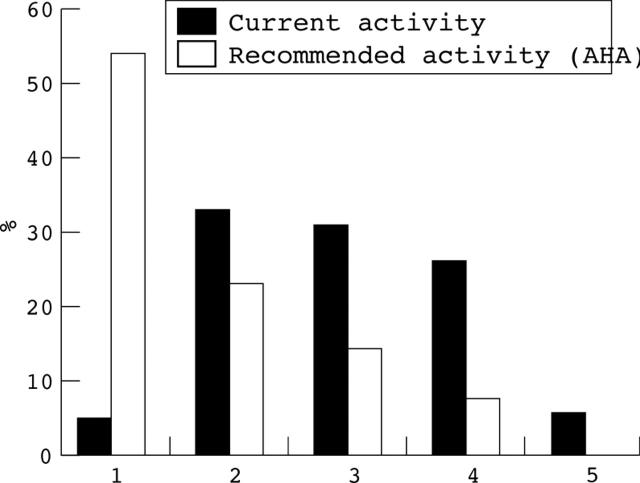Abstract
OBJECTIVE—To determine if appropriate advice had been given to adults with congenital heart disease regarding safe and effective exercise, and to assess pre-existing misconceptions of the potential benefits and dangers of exercise. DESIGN—An anonymous self assessment questionnaire. SETTING—A tertiary referral clinic. PATIENTS—99 adults (57 men, 42 women) with congenital heart disease, mean age 25.6 years. MAIN OUTCOME MEASURES—The extent and nature of exercise advice given over previous years; a measure of current activity level compared with the American Heart Association recommendations; and an assessment of exercise limiting symptoms and a description of barriers to further exercise. RESULTS—44% of the cohort assumed all exercise was safe despite their cardiac disease. A health care professional had only raised the issue of specific exercise advice in 28 cases. Of those given instruction it was more common to receive prohibitive advice (30%) than to be encouraged to take more exercise (19%). Despite this 61% were involved in some form of at least light exercise. The most prevalent barriers to exercise were current symptoms (32.3%), lack of interest in exercise (24.2%), and health fears (16.1%). CONCLUSIONS—The education of adults with congenital heart disease regarding exercise and its potential benefits and limitations is suboptimal even in a specialist clinic. Keywords: congenital heart defects; exercise prescription
Full Text
The Full Text of this article is available as a PDF (71.2 KB).
Figure 1 .
Current activity level (scale 1-5) of study subjects compared to AHA recommended activity level.
Selected References
These references are in PubMed. This may not be the complete list of references from this article.
- Hutchins G. M., Moore G. W., Hatton E. V. Arterial-venous relationships in the human left ventricular myocardium: anatomic basis for countercurrent regulation of blood flow. Circulation. 1986 Dec;74(6):1195–1202. doi: 10.1161/01.cir.74.6.1195. [DOI] [PubMed] [Google Scholar]
- Leonard H., O'Sullivan J. J., Hunter S. Family planning requirements in the adult congenital heart disease clinic. Heart. 1996 Jul;76(1):60–62. doi: 10.1136/hrt.76.1.60. [DOI] [PMC free article] [PubMed] [Google Scholar]
- Swinburn B. A., Walter L. G., Arroll B., Tilyard M. W., Russell D. G. Green prescriptions: attitudes and perceptions of general practitioners towards prescribing exercise. Br J Gen Pract. 1997 Sep;47(422):567–569. [PMC free article] [PubMed] [Google Scholar]
- Williford H. N., Barfield B. R., Lazenby R. B., Olson M. S. A survey of physicians' attitudes and practices related to exercise promotion. Prev Med. 1992 Sep;21(5):630–636. doi: 10.1016/0091-7435(92)90070-x. [DOI] [PubMed] [Google Scholar]



